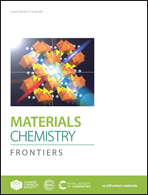Blue photoluminescence enhancement achieved by zero-dimensional organic indium halides via a metal ion doping strategy†
Abstract
Low-dimensional organic–inorganic metal halide hybrids exhibit promising optical properties for light emitting applications. However, developing lead-free blue-light emitters with high photoluminescence quantum efficiency (PLQE) remains an ongoing challenge. In our work, a novel zero-dimensional (0D) indium hybrid compound (MA)4InCl7 (MA = CH3NH3+) was developed which exhibited broadband blue emission with a PLQE of 11.2% when excited by ultraviolet (UV) light. More interestingly, upon Cs+ or Mn2+ doping, the emission of the 0D compound further blue-shifted and became narrower, while the PLQE was significantly enhanced to 18.8% (Cs+) or 20.7% (Mn2+). More prominent PLQE enhancement to 74.7% was observed after Sb3+ doping, which also altered the emission spectrum to the orange region. According to experimental characterization and theoretical calculations, we attribute the PLQE enhancement upon Cs+ and Mn2+ doping to defect passivation and the orange emission upon Sb3+ doping to altered emission centers. We have demonstrated that multiple metal ions possess the ability to improve the light emitting properties of 0D organic–inorganic metal halides, and (MA)4InCl7 could be utilized as a Sb3+ heavy metal ion sensor with high selectivity and sensitivity.



 Please wait while we load your content...
Please wait while we load your content...